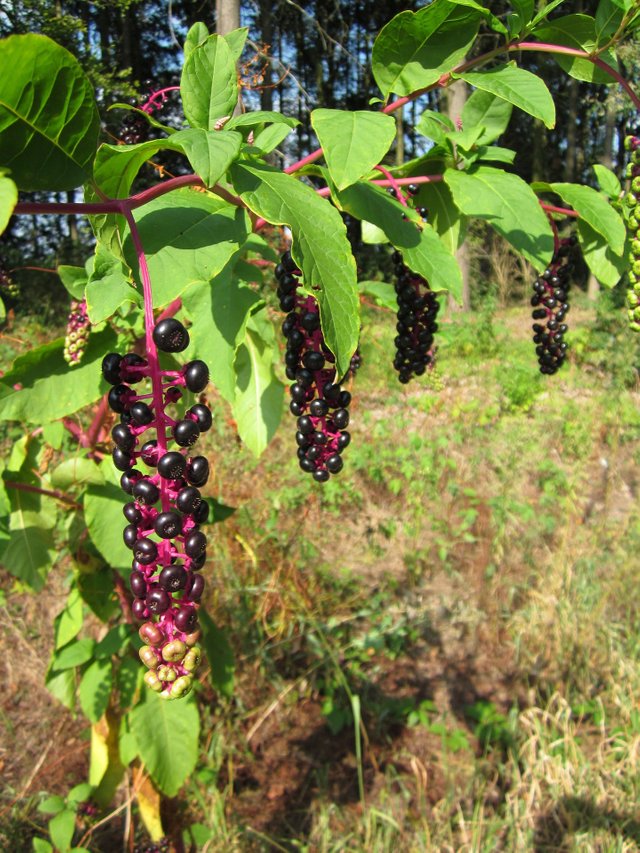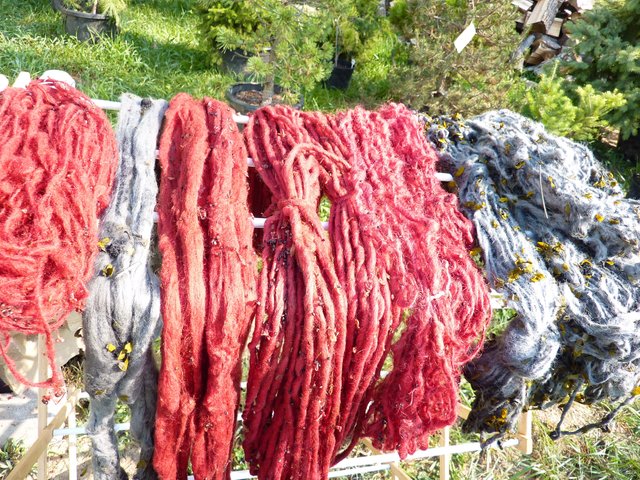Herbal Allies 4. Pokeberry
Do you know this herbal ally? It is a long time favorite of mine.
That's right, even some poisonous plants can still be allies.
Phytolacca americana has a thick juicy pink stem that can reach the size of your forearm. It has large ovate rubbery green leaves and in late summer- tons of bright purple berries which are happily carried off by wild birds.
It is a strong weed. I've seen it grow to 8 feet tall! One tiny little sprout can turn into a huge shrub in just one year.
"Poke", as we call her around here- has a deep, thick, tough white taproot, making it quite difficult to relocate once established. It is native to Eastern United States.
The plant is considered poisonous to ingest and in some cases may cause dermatological allergic reactions.
I use the berries for this bright pink dye!
I gather the berries in late summer and then mash them with water and bring it to a heat that is oh-so-close to a simmer, but not quite... Then I add a lot of apple cider vinegar to fix the color, and then the yarn.
Now... Back when we lived in the Appalachian mountains in North Carolina, we learned that the old time folk down there eat some berries in a very strategic way.... Supposedly this is an old folk remedy to prevent cancer. (Don't try this at home kids) When the berries come into full ripeness in the summer a person eats one berry on day one, two berries on day two, three berries on day three... up to day five with five berries. Then, on day six, decreases to four berries, on day seven they eat three berries, and then back down to one berry on day nine. We too do this every year or so. And I will complete this paragraph by saying what my stepdad used to say to me, "Do as I say, not as I do"...
Back when we were a bit younger and wilder, and living in those sweet smelling mountains, we would also eat the early spring shoots of poke and called it as the locals did "Poke Salat" ... We'd cut them like asparagus when they were just a few inches tall, and steam them in two changes of water. I will say that was one delicious poisonous plant! (Again, don't try this at home!)
In all seriousness, it is true that many of our sacred herbal allies have been demonized by scientists fiddling with them in their labs and getting unsavory results, as well as some misinformed people going and cooking themselves up a bunch of leaves they found and getting sick (or worse).
In our experiences we were using this plant very sparingly as food or medicine, and under the guidance of wise herbalists and folk healers. It is crucial to understand not only plant identification but many other subtleties such as exact harvest methods, time of harvest, and exact preparations...
We suggest everyone do their own research and consult a professional before ingesting any new plants!
Susan Weed, a time honored herbalist says in her herbal e-zine
pokeweed—an old favorite of wise women dealing with breast lumps and breast cancer. If I felt a suspicious lump, I’d reach for poke root oil. It reduces congestion, relieves swelling, and literally dissolves growths in the breasts.
Jethro Kloss, author of the classic herbal Back to Eden, used freshly grated raw poke root poultices to burn away breast cancer. Caution: Fresh poke placed directly on the skin is strong enough to damage healthy tissues as well as cancerous ones.
The infused oil is also effective and far safer. A generous amount is gently applied to the lump, covered with a flannel cloth and then with a hot water bottle (no heating pads), and left on for as long as you’re comfortable. This is repeated at least twice a day. Poke root oil is too powerful for regular preventive care. Caution: Poke oil can cause a rash on sensitive skin. Ingestion of poke oil can cause severe intestinal distress.


Very interesting read. Phytolacca is used homeopathically for tendinitis, bursitis and rheumatism in cold weather. Now that is in homeopathic form not in a tincture or straight from the plant.
I have never seen the plant before. I like the idea that it can be used as a dye. Question: When working on the plant with your hands is there a risk of absorption? Clearly there is not a huge risk but if you left the juices on your hands is there a small chance? The reason I ask is we grew tobacco this year and we needed to glove up because we actually absorbed the tobacco through our hands. This might be great for someone who enjoys tobacco but we don't. It was quite a buzz.
Ohhh I haven't personally had any bad reactions. I know that our hands can definitely soak things in though. I can see why the tobacco would be problematic. With the pokeberry I believe it is more of a toxicity that can cause severe vomiting if ingested, and on the skin it can cause contact dermatitis in some individuals...
Homeopathy is very fascinating. Do you blog about it as well?
I would like to learn more about it! Thanks a lot for reading my post and for stopping by!
Good to know that it is ok externally. That is so cool that we can work with a substance and it not bother us but to eat it is a completely different story.
I actually don't blog about homeopathy yet. I need to, I am just not sure where to start there is so much to talk about. I will get there.
I wouldn't say it's "ok externally" for everyone. as I said above, "on the skin it can cause contact dermatitis in some individuals..."
Yes, sorry. I was thinking of you externally. I will keep in mind that it can cause contact dermatitis for some. Thank you for the clarification :)
oh okay! Just making sure ;-) Thanks!
and also in the article above where I quoted Susan Weed it goes into detail about how it can cause severe burning of tissues on the skin. Did you see that part? I just haven't personally had reactions to the berries.
Yes I did read that. Again thank you for pointing that out. All good points to remember. I think it is important to work with someone who knows about these kind of things especially when first learning.
Yes i totally agree!
This may be having such anti-cancerous activity. There may be reports of this plant in literature, if not then it could be potential to study for the same....
Nice informative article..😊
It may be, indeed. Worth further research and careful handling! Thanks for reading!
I have heard back and forth about injesting poke for years, now I understand it, thank you. The dye colour is stunning....I did not know it was that striking!
Thanks for reading! Yes I am pretty impressed with the dye color too. I forgot to post this picture showing some finished yarn - the red skeins are dyed with poke
Beautiful!!!
beautiful rich color!
We use the berries for arthritis, swallow whole 3 a day for 5 days then rest a week.
Isn't that interesting!?
The Cherokee used the berries this way also.
Love how you wrote this! It was informative and fun to read, thanks for me educating me while telling me a story!
haha oh good! thank you for reading!
We've got these bushes all over the place around here, so this was really interesting. These plants are pretty beautiful for such an invasive weed. I've heard they are actually cultivated for decoration in the UK.
When I was a kid we'd run around throwing the berries at each other. It was sort of a primitive version of paint-ball, since it looked like we'd been shot if we got hit.
I'd love to see how you prepare the dyes. We might try it this summer.
Oh that is so cute! The primitive paintball! HAhaha Love it!!
That is so interesting. We have those plants growing every year on our farm. Never knew they were good for anything.
Well at the very least the berries can make a nice dye! Make sure the kids know not to eat them and maybe use gloves to collect them! My hands were stained red for a few days!
My brother swears they used to eat them when he was a kids. He and his friends were always into stuff, though. It may not be a cancer preventive, though, because he's a cancer survivor. Maybe it's specific to breast cancer? He had a really rare lymphoma and was lucky to survive it. I do worry if the long term effects of the chemo will come back to bite him. Such toxic stuff.
We also used to occasionally get poke salad when we lived in Asheville. Like you said, not bad for poison.
Yeah it's interesting. Congrats on his survival. When we lived in Appalachia, it was specifically noted that the berries needed to be eaten in a certain way in order to be a general "cancer preventative". But as in almost all other herbs for medicine, they usually aren't going to be able to reach their full effectiveness if they are not also combined with other complimenting lifestyle factors, and used with consistency...
Thank you. He's more than 6 years cancer free, and we celebrate his birthdays with extra fervor. It was an awful experience, especially for my parents and his children who were 12 and 10. He was pretty hard on his body in the teens and early 20s. He toned down his toxin intake only to take up serious stress and general grumpiness which obviously has a horrible effect on the body. Those seem to be harder habits to kick. I guess we are all here learning and growing from where we are, and I just love him where he's at.
A regular spring time dinner side at my gram’s house was young poke greens.
I don't think we have Pokeweed in Pakistan but it does seem like a wonderful herb. My aunt is quite interested in herbs and uses a lot of them to treat many little to big ailments and honestly they work better than medicines.